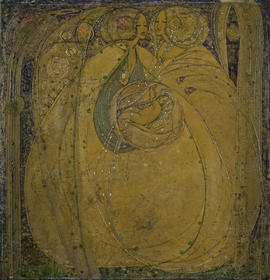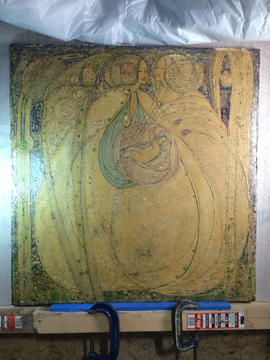Key Information
Reference code
Title
Date(s)
- 1901 (Creation)
Level of description
Item
Extent
1
Content and Structure
Scope and content
Designed for the 'Rose Boudoir', International Exhibition of Modern Decorative Art, Turin, 1902. This item was assessed for conversation in 2010 as part of the Mackintosh Conservation and Access project (2006-2010), and then again in 2018 following the fire in the Mackintosh Building in June 2018.
A Rose Boudoir included two gesso panels - composite works of plaster with pigment, set with glass beads - made exclusively by Macdonald. On the manifest for the exhibition, Mackintosh indicated that ‘duplicates only’ were available for sale. Two other versions, both in Glasgow, had the same design but with different palette and surface detail: The White Rose and the Red Rose hung above the mantle in the Mackintoshes’ own home, and can now be seen in the Mackintosh House at the Hunterian Art Gallery; and The Heart of the Rose belonged to Wylie Hill, a relative of Jessie Newbery, and was later given to the Glasgow School of Art. Previously it was assumed that these versions were created from a cartoon or template, each hand made, but it was difficult to tell which set came first, or even if they were made simultaneously. But recent analysis by Graciela Ainsworth Conservation Studio in Edinburgh has shown that the GSA version is not a gesso panel as we have come to understand Macdonald’s technique, but rather a traditional plaster cast that has been painted. This may seem like a minor technical point, but when considered alongside Mackintosh’s note that duplicates could be ordered, it reminds us that he carefully curated this space to show both that he and Macdonald could be commissioned to do entire rooms but were also very happy to have individual pieces replicated and sold on their own merit (information supplied by Dr Robyne Erica Calvert, Cultural Historian, Mar 2022).
Appraisal, destruction and scheduling
Accruals
System of arrangement
General Information
Name of creator
Biographical history
Margaret Macdonald was one of the most gifted and successful women artists in Scotland at the turn of the century. Her output was wide-ranging and included watercolours, graphics, metalwork and textiles. Arguably her greatest achievements were in gesso, a plaster-based medium, which she used to make decorative panels for furniture and interiors.
Macdonald was born in England and came to Glasgow with her family around 1890. She enrolled as a day student at Glasgow School of Art, recording 9 Windsor Terrace, Glasgow as her home address.
GSA records reveal a successful school career:
1891: Local exam, advanced, Stage 23c, ornamental design, second class
1891: Local exam, 2nd grade certificate, freehand drawing, 2nd class
1891: Local exam, 2nd grade certificate, model drawing, 2nd class
1891: Local prize, Design section, majolica, 1st prize, 10/-
1891: Local exam., advanced, Stage 9a, anatomy, 1st class
1892: Local exam., advanced, Stage 8c, drawing from life, 2nd class
1892: Local exam, advanced, composition from given figure subject, 2nd class
1894: Local prize, Design section, stained glass design, 2nd prize
It was at GSA she met Mackintosh and Herbert McNair. Leaving the School in the mid 1890s, she set up an independent studio in the city with her sister, Frances. Margaret Macdonald The sisters worked together until Frances’s marriage and departure for Liverpool in 1899. Mackintosh and Macdonald married in 1900.
Collaboration was key to Margaret Macdonald’s creativity. The partnership with her sister in the 1890s produced metalwork, graphics, and a series of book illustrations. Her collaboration with Mackintosh comprised primarily the production of panels for interiors and furniture, notably for the tea rooms and The Hill House. The precise nature of their partnership is difficult to define, because little documentation survives. However it is certain that Macdonald played an important role in the development of the decorative, symbolic interiors of the early 1900s, including the House for an Art Lover portfolio, the Rose Boudoir, Turin and the Willow Tea Rooms.
Ill health and the strain of Mackintosh’s declining career contributed to a decline in her own output and no work after 1921 is known. Macdonald died in London in 1933, five years after her husband.
Archival history
Exhibited: Turin; 1902. New York, Museum of Modern Art (+ tour); 1960. London, Royal Academy; 1971. Glasgow and Helensburgh; 1976. Glasgow, Fine Arts Society; 1979. Glasgow, Hunterian Art Gallery; 1983. Glasgow, Glasgow School of Art; 1988. Glasgow, Glasgow School of Art; 1990. Exhibited in New York in 1960 under the title "Motherhood". This item is currently on display in The Glasgow School of Art's Reid Building. For access information please email archives@gsa.ac.uk.
Custodial history
Donated by the Wylie Hill Trust, via Mrs P Burrell (Perth) and Mrs W D Lang (Paisley) in 1952
Physical Description and Conditions of Use
Conditions governing access
Conditions governing reproduction
Language of material
Script of material
Language and script notes
Physical Description
Painted gesso. Reframed, back into original (period) frame, May 1996. Previous (double) frame had been made c1985.
Dimensions: 968 x 940 mm
Finding aids
Related Material
Existence and location of originals
Existence and location of copies
Related materials
Notes area
Alternative identifier(s)
Keywords/Tags
Subjects
Place access points
People and Organisations
- Mackintosh, Margaret Macdonald (Subject)





